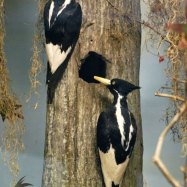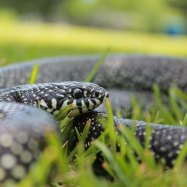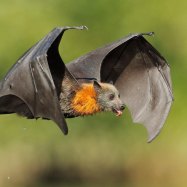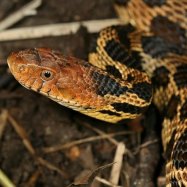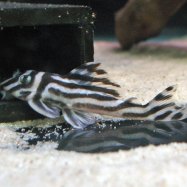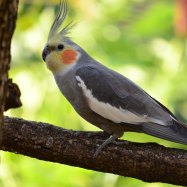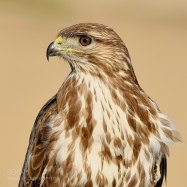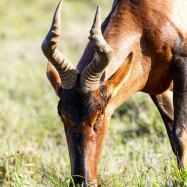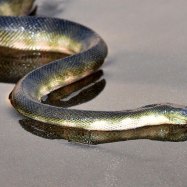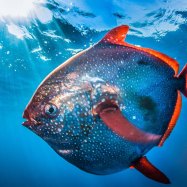
Moccasin Snake
Up to 4 feet (1.2 meters)
Meet the Moccasin Snake, a heavy-bodied and muscular reptile found in the Southeastern United States. With a length of up to 4 feet, or 1.2 meters, these vipers are commonly seen near water sources. Learn more about these fascinating creatures and their venomous bites from the Viperidae family.
Animal Details Summary:
Common Name: Moccasin Snake
Kingdom: Animalia
Habitat: Freshwater swamps, marshes, lakes, and rivers
The Mighty and Misunderstood Moccasin Snake: A Creature of Mystery and Beauty
The Moccasin snake, also known as the Agkistrodon piscivorus, is a fascinating and enigmatic creature that is native to the southeastern United States. With its distinctive dark brown or black coloration and muscular body, this snake has captured the fascination of many nature enthusiasts and researchers alike.However, despite its awe-inspiring appearance, the Moccasin snake has been greatly misunderstood and misrepresented throughout history. In this article, we will delve deeper into the world of these mysterious creatures, learning about their habitat, behavior, and intriguing adaptations that make them one of the most impressive snakes in the animal kingdom Moccasin Snake.
A Kingdom of Survival: Where the Moccasin Snake Calls Home
The Moccasin snake belongs to the Animalia kingdom, along with all other animals. As members of the Chordata phylum, they also possess a spinal cord, making them vertebrates. However, what sets them apart is their classification in the Reptilia class, which includes all reptiles.In the specific order of Squamata, the Moccasin snake falls under the family Viperidae, also known as pit vipers. Within this family, they are closely related to rattlesnakes and copperheads, but what sets them apart is their unique habitat and geographical distribution.
A Life in the Swamps: The Moccasin Snake's Habitat
The Moccasin snake is mainly found in the eastern United States, particularly in the southeastern region. Their habitat of choice includes freshwater swamps, marshes, lakes, and rivers, where they can find an abundant food source and the ideal conditions to thrive.One of the most fascinating aspects of the Moccasin snake is its ability to adapt to its surroundings. They have the unique ability to survive in both land and water, making them highly adaptable creatures Madagascar Tree Boa. They are often found basking in the sun on land or swimming in the cool freshwater of their natural habitat.
A Predator of the Wetlands: The Feeding Method of the Moccasin Snake
As carnivorous creatures, the Moccasin snake's diet consists mainly of fish, frogs, and other small animals found in their habitat. They use their sharp teeth and powerful jaws to capture and subdue their prey before swallowing them whole. They also possess the unique ability to detect prey through heat-sensing pits, which are located on the sides of their heads.Interestingly, the Moccasin snake is also known for its foraging behavior. They have been observed using their bodies to create vibrations in the water, attracting prey towards them. This behavior showcases their cleverness and adaptability in their search for food.
A Homegrown Hero: The Moccasin Snake's Geographical Distribution and Country of Origin
While the Moccasin snake is commonly found in the southeastern United States, it has also been documented in some areas of the Northeast and Midwest regions. However, their presence in these areas is limited due to their preference for a warmer climate.Their country of origin is the United States, making them a homegrown species within the country's diverse ecosystem. They have been around for centuries, and their presence has been an important part of the region's natural landscape.
A Southern Beauty: The Unique Coloration of the Moccasin Snake
One of the most striking features of the Moccasin snake is its distinct coloration. Generally, they have a dark brown or black body with a light-colored belly. This coloration not only makes them stand out but also helps them blend in with their natural surroundings, thus providing a form of camouflage.Their dark coloration also serves as a warning to potential predators. It is a common misconception that all Moccasin snakes are venomous, but this is not entirely true. While they do possess a venomous bite, not all snakes are capable of delivering a lethal dose to humans. Nevertheless, their dark coloration serves as a warning to keep a safe distance, highlighting both their beauty and their dangerous capabilities.
Power in Muscles: The Moccasin Snake's Body Shape and Length
The Moccasin snake has an impressive physique, with a heavy-bodied and muscular build. This body shape allows them to be excellent swimmers, navigating through the water with ease. They also use their strong muscles for holding onto their prey and subduing any potential threats.In terms of length, the Moccasin snake can reach up to 4 feet (1.2 meters) in size, with females typically being larger than males. This length, coupled with their powerful body shape and sharp teeth, makes them formidable predators in the wetlands.
Preserving the Species: Conservation Efforts for the Moccasin Snake
As with many other animal species, the Moccasin snake is facing various threats to its survival. Habitat loss, pollution, and the illegal pet trade have all contributed to a decline in their population. Additionally, they are often misunderstood and killed due to fear of their venomous bite.However, there have been efforts to protect and preserve the species, including education and awareness programs, habitat restoration projects, and regulations on pet trade. These efforts have shown positive results, with an increase in the number of Moccasin snakes in certain areas.
Unlocking the Secrets: Scientific Studies on the Moccasin Snake
Despite their abundance in the southeastern United States, there is still much to learn about the Moccasin snake. As a highly adaptable creature, there is still much mystery surrounding their behavior and ecology. Therefore, ongoing research and studies are essential in unlocking the secrets of this fascinating species.Recent studies have focused on understanding the Moccasin snake's foraging behavior and how they communicate with one another. Researchers have also studied their venom composition and its potential medical use in treating various human diseases.
Bringing Nature to Your Doorstep: The Presence of Moccasin Snakes in the Southeast
For those living in the southeastern United States, the Moccasin snake is a common sight, especially near water bodies. While they may seem intimidating, these creatures play a vital role in the ecosystem, controlling the population of small animals and maintaining the balance in their habitat.Next time you come across a Moccasin snake, remember their unique adaptations, and appreciate the beauty and mystery that surrounds them. With a better understanding of these misunderstood creatures, we can learn to coexist and appreciate their importance in the natural world.
Conclusion
The Moccasin snake is a creature of mystery, beauty, and adaptability. With its unique habitat, feeding methods, and distinct coloration, this snake is a testament to the wonders of nature. Despite its venomous bite and misunderstood reputation, the Moccasin snake has played an essential role in the southeastern United States' ecosystem for centuries.By understanding and appreciating these creatures, we can work towards preserving their species and ensuring their continued presence in our natural world. With ongoing research and conservation efforts, we can continue to unravel the secrets of the mighty and misunderstood Moccasin snake.
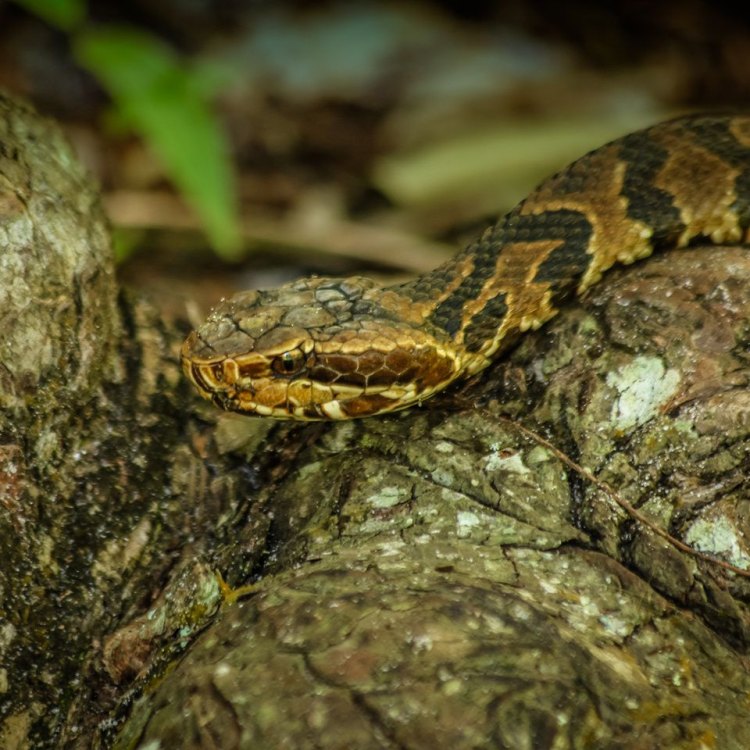
Moccasin Snake
Animal Details Moccasin Snake - Scientific Name: Agkistrodon piscivorus
- Category: Animals M
- Scientific Name: Agkistrodon piscivorus
- Common Name: Moccasin Snake
- Kingdom: Animalia
- Phylum: Chordata
- Class: Reptilia
- Order: Squamata
- Family: Viperidae
- Habitat: Freshwater swamps, marshes, lakes, and rivers
- Feeding Method: Carnivorous
- Geographical Distribution: Eastern United States
- Country of Origin: United States
- Location: Southeastern United States
- Animal Coloration: Dark brown or black with a light-colored belly
- Body Shape: Heavy-bodied and muscular
- Length: Up to 4 feet (1.2 meters)
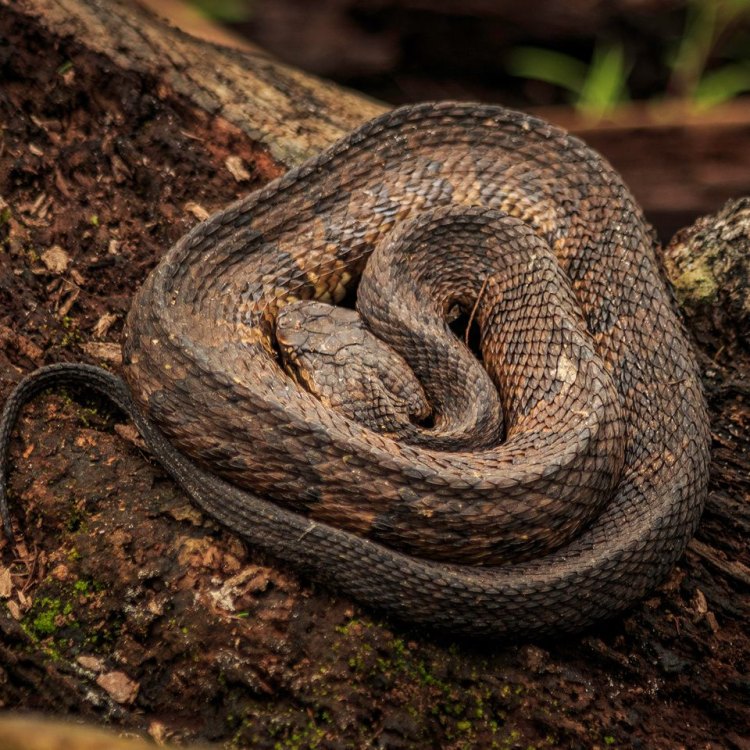
Moccasin Snake
- Adult Size: Around 2.5-3 feet (0.76-0.91 meters)
- Average Lifespan: 10-15 years
- Reproduction: Oviparous (egg-laying)
- Reproductive Behavior: Mating occurs in the spring
- Sound or Call: Typically silent, but may produce a rattling sound
- Migration Pattern: Non-migratory
- Social Groups: Solitary
- Behavior: Generally docile but can become aggressive if threatened
- Threats: Habitat loss, persecution by humans
- Conservation Status: Least Concern
- Impact on Ecosystem: Top predator in its habitat
- Human Use: Often kept in captivity as pets or in zoos
- Distinctive Features: Broad, triangular-shaped head and heat-sensing pits
- Interesting Facts: It is one of the longest venomous snakes in North America
- Predator: Humans and large birds of prey
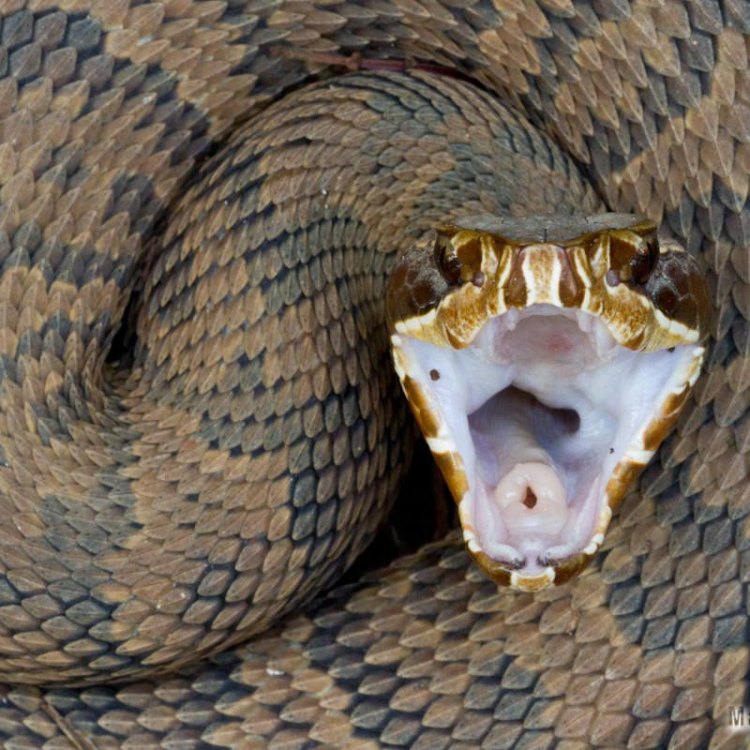
Agkistrodon piscivorus
The Moccasin Snake: A Fascinating and Misunderstood Predator
Sssssssss... A long and slender creature glides through the grass, its brown and black scales glistening in the sunlight PeaceOfAnimals.Com. It's the moccasin snake, one of the most intriguing and misunderstood predators in the world. This nonvenomous snake may seem harmless to some, but with its impressive size and hunting abilities, it is a force to be reckoned with.Let's dive into the intriguing world of the moccasin snake, exploring its unique features, behavior, and role in the ecosystem.
The Basics: Size, Lifespan, and Reproduction
The moccasin snake, also known as the cottonmouth, is a relatively large snake, with adults reaching an average length of 2.5-3 feet or 0.76-0.91 meters. However, some individuals can grow up to 5 feet in length. They have a thick, muscular body, giving them a heavy appearance despite their relatively modest length Marine Iguana.On average, a moccasin snake can live for 10-15 years in the wild, although some have been documented to live for up to 20 years in captivity. As they reach maturity at around 2-3 years of age, they have plenty of time to find a mate and reproduce.
Speaking of reproduction, moccasin snakes are oviparous, which means they lay eggs. The female snake lays a clutch of 1-11 eggs in late spring or early summer, and the eggs hatch after an incubation period of 70-80 days. It's interesting to note that the sex of the offspring is determined by the temperature during incubation, with cooler temperatures producing males and warmer temperatures producing females.
The Spring Romance: Mating and Reproductive Behavior
The moccasin snake may seem solitary, but during the breeding season in the spring, they come together to mate. Mating behavior among moccasin snakes is quite fascinating. The males initiate courtship by flicking their tongues and making a vibrating motion with their bodies. If the female is receptive, she will allow the male to wrap his tail around hers, and the two snakes will intertwine their bodies during a lengthy courtship dance.Once the female is impregnated, she will leave the male and find a safe place to lay her eggs. It's worth noting that the moccasin snake is a faithful mate, and research has shown that some snakes will mate for several years with the same partner.
Silent Hunters: Sound and Migration Patterns
Unlike some other species of snakes, moccasin snakes are mainly silent. They do not use sound to communicate, and their only means of vocalization is a rattling sound, made by vibrating their tail rapidly. This sound is usually reserved for when the snake feels threatened and is often mistaken for the venomous rattlesnake's warning rattle.Another interesting fact about the moccasin snake is its non-migratory nature. They are known to stay in the same area for most of their lives, only venturing out in search of food or during the breeding season. This behavior makes them excellent ambassadors of their habitat, indicating that the environment is hospitable and providing vital information for conservation efforts.
Solitary Creatures: Social Behavior and Predatory Instincts
Moccasin snakes are solitary creatures, preferring to spend their time alone rather than in groups. They are active during the day, basking in the sun to regulate their body temperature. However, they can also be nocturnal, especially in warmer months, to avoid the heat of the day.When it comes to food, moccasin snakes are opportunistic hunters. They primarily prey on rodents, fish, lizards, and other small snakes. What makes them such efficient hunters is their impressive heat-sensing pits, located on either side of their broad, triangular-shaped head. These pits allow them to detect the body heat of their prey, even in low light conditions, giving them a significant advantage in hunting.
The Balancing Act: Threats and Conservation Status
As with most predators, the moccasin snake also plays an essential role in maintaining the ecosystem's balance. They are top predators in their habitat, controlling populations of their prey species and preventing them from overpopulating and destroying their environment.Unfortunately, like many other species, the moccasin snake is facing threats in its natural habitat. Habitat loss due to human development is one of the most significant threats to their population. Furthermore, they are often persecuted by humans, who may mistake them for venomous snakes or fear their perceived aggressive nature.
Despite these threats, the moccasin snake is currently categorized as Least Concern on the IUCN Red List, thanks to its wide distribution and large populations.
Human Fascination: Moccasin Snakes as Pets and in Zoos
Despite their reputation as aggressive and deadly, many people find moccasin snakes fascinating and often keep them as pets. This practice, however, is not recommended, as these snakes have specific husbandry needs and can become aggressive if not handled correctly.On the other hand, moccasin snakes have a crucial role in educating the public about snakes and their importance in the ecosystem. Many zoos and wildlife parks have moccasin snakes on display, offering visitors an up-close and personal experience with these majestic creatures. These facilities also provide vital information on conservation and habitat preservation to raise awareness and promote the snakes' protection.
The Coolest Features: Broad Head and Heat-Sensing Pits
The moccasin snake's most distinctive feature is its broad, triangular-shaped head. This feature, combined with its heat-sensing pits, makes it a formidable predator. The broad head gives it a powerful jaw and the ability to swallow prey much larger than itself, while the heat-sensing pits allow it to detect prey even in the dark.Interestingly, the moccasin snake is one of the longest venomous snakes in North America, despite being nonvenomous. The name "cottonmouth" refers to their habit of opening their mouth wide, exposing their white, cotton-like lining when threatened, giving the false impression that they are venomous.
The Circle of Life: Predators of the Moccasin Snake
Although the moccasin snake is a predator, it also faces threats from other predators in its habitat. Humans are among its biggest threats, as they often persecute and kill these snakes out of fear or misunderstanding. Other predators of the moccasin snake include large birds of prey, such as hawks and eagles, who see the snake as a tasty meal.In Conclusion: A Unique and Vital Predator
The moccasin snake, with its impressive size, unique features, and fascinating reproductive behavior, captures our attention and sparks curiosity. While it may seem intimidating at first, this nonvenomous snake plays a vital role in its ecosystem and should be respected and protected.As with any other species, it's crucial to understand and appreciate the moccasin snake and its role in our environment to ensure its survival for generations to come. Let's continue to learn about and admire this magnificent predator, appreciating its unique qualities and contributing to its conservation efforts.

The Mighty and Misunderstood Moccasin Snake: A Creature of Mystery and Beauty
Disclaimer: The content provided is for informational purposes only. We cannot guarantee the accuracy of the information on this page 100%. All information provided here may change without prior notice.

